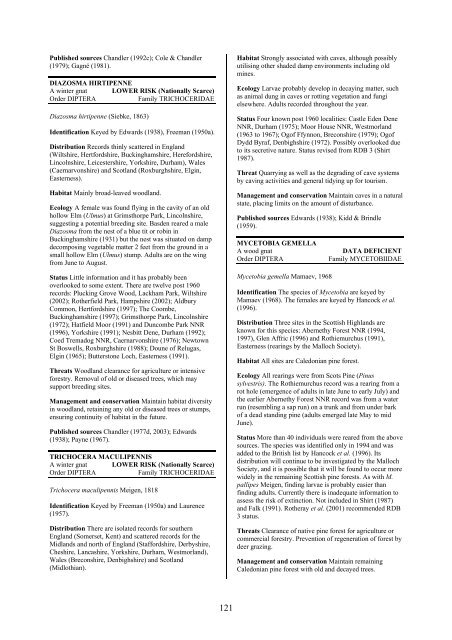Part 2: Nematocera and Aschiza not dealt with by Falk (1991) - JNCC
Part 2: Nematocera and Aschiza not dealt with by Falk (1991) - JNCC
Part 2: Nematocera and Aschiza not dealt with by Falk (1991) - JNCC
You also want an ePaper? Increase the reach of your titles
YUMPU automatically turns print PDFs into web optimized ePapers that Google loves.
Published sources Ch<strong>and</strong>ler (1992c); Cole & Ch<strong>and</strong>ler<br />
(1979); Gagné (1981).<br />
DIAZOSMA HIRTIPENNE<br />
A winter gnat LOWER RISK (Nationally Scarce)<br />
Order DIPTERA<br />
Family TRICHOCERIDAE<br />
Diazosma hirtipenne (Siebke, 1863)<br />
Identification Keyed <strong>by</strong> Edwards (1938), Freeman (1950a).<br />
Distribution Records thinly scattered in Engl<strong>and</strong><br />
(Wiltshire, Hertfordshire, Buckinghamshire, Herefordshire,<br />
Lincolnshire, Leicestershire, Yorkshire, Durham), Wales<br />
(Caernarvonshire) <strong>and</strong> Scotl<strong>and</strong> (Roxburghshire, Elgin,<br />
Easterness).<br />
Habitat Mainly broad-leaved woodl<strong>and</strong>.<br />
Ecology A female was found flying in the cavity of an old<br />
hollow Elm (Ulmus) at Grimsthorpe Park, Lincolnshire,<br />
suggesting a potential breeding site. Basden reared a male<br />
Diazosma from the nest of a blue tit or robin in<br />
Buckinghamshire (1931) but the nest was situated on damp<br />
decomposing vegetable matter 2 feet from the ground in a<br />
small hollow Elm (Ulmus) stump. Adults are on the wing<br />
from June to August.<br />
Status Little information <strong>and</strong> it has probably been<br />
overlooked to some extent. There are twelve post 1960<br />
records: Plucking Grove Wood, Lackham Park, Wiltshire<br />
(2002); Rotherfield Park, Hampshire (2002); Aldbury<br />
Common, Hertfordshire (1997); The Coombe,<br />
Buckinghamshire (1997); Grimsthorpe Park, Lincolnshire<br />
(1972); Hatfield Moor (<strong>1991</strong>) <strong>and</strong> Duncombe Park NNR<br />
(1996), Yorkshire (<strong>1991</strong>); Nesbitt Dene, Durham (1992);<br />
Coed Tremadog NNR, Caernarvonshire (1976); Newtown<br />
St Boswells, Roxburghshire (1988); Doune of Relugas,<br />
Elgin (1965); Butterstone Loch, Easterness (<strong>1991</strong>).<br />
Threats Woodl<strong>and</strong> clearance for agriculture or intensive<br />
forestry. Removal of old or diseased trees, which may<br />
support breeding sites.<br />
Management <strong>and</strong> conservation Maintain habitat diversity<br />
in woodl<strong>and</strong>, retaining any old or diseased trees or stumps,<br />
ensuring continuity of habitat in the future.<br />
Published sources Ch<strong>and</strong>ler (1977d, 2003); Edwards<br />
(1938); Payne (1967).<br />
TRICHOCERA MACULIPENNIS<br />
A winter gnat LOWER RISK (Nationally Scarce)<br />
Order DIPTERA<br />
Family TRICHOCERIDAE<br />
Trichocera maculipennis Meigen, 1818<br />
Identification Keyed <strong>by</strong> Freeman (1950a) <strong>and</strong> Laurence<br />
(1957).<br />
Distribution There are isolated records for southern<br />
Engl<strong>and</strong> (Somerset, Kent) <strong>and</strong> scattered records for the<br />
Midl<strong>and</strong>s <strong>and</strong> north of Engl<strong>and</strong> (Staffordshire, Der<strong>by</strong>shire,<br />
Cheshire, Lancashire, Yorkshire, Durham, Westmorl<strong>and</strong>),<br />
Wales (Breconshire, Denbighshire) <strong>and</strong> Scotl<strong>and</strong><br />
(Midlothian).<br />
Habitat Strongly associated <strong>with</strong> caves, although possibly<br />
utilising other shaded damp environments including old<br />
mines.<br />
Ecology Larvae probably develop in decaying matter, such<br />
as animal dung in caves or rotting vegetation <strong>and</strong> fungi<br />
elsewhere. Adults recorded throughout the year.<br />
Status Four known post 1960 localities: Castle Eden Dene<br />
NNR, Durham (1975); Moor House NNR, Westmorl<strong>and</strong><br />
(1963 to 1967); Ogof Ffynnon, Breconshire (1979); Ogof<br />
Dydd Byraf, Denbighshire (1972). Possibly overlooked due<br />
to its secretive nature. Status revised from RDB 3 (Shirt<br />
1987).<br />
Threat Quarrying as well as the degrading of cave systems<br />
<strong>by</strong> caving activities <strong>and</strong> general tidying up for tourism.<br />
Management <strong>and</strong> conservation Maintain caves in a natural<br />
state, placing limits on the amount of disturbance.<br />
Published sources Edwards (1938); Kidd & Brindle<br />
(1959).<br />
MYCETOBIA GEMELLA<br />
A wood gnat<br />
Order DIPTERA<br />
Mycetobia gemella Mamaev, 1968<br />
DATA DEFICIENT<br />
Family MYCETOBIIDAE<br />
Identification The species of Mycetobia are keyed <strong>by</strong><br />
Mamaev (1968). The females are keyed <strong>by</strong> Hancock et al.<br />
(1996).<br />
Distribution Three sites in the Scottish Highl<strong>and</strong>s are<br />
known for this species: Abernethy Forest NNR (1994,<br />
1997), Glen Affric (1996) <strong>and</strong> Rothiemurchus (<strong>1991</strong>),<br />
Easterness (rearings <strong>by</strong> the Malloch Society).<br />
Habitat All sites are Caledonian pine forest.<br />
Ecology All rearings were from Scots Pine (Pinus<br />
sylvestris). The Rothiemurchus record was a rearing from a<br />
rot hole (emergence of adults in late June to early July) <strong>and</strong><br />
the earlier Abernethy Forest NNR record was from a water<br />
run (resembling a sap run) on a trunk <strong>and</strong> from under bark<br />
of a dead st<strong>and</strong>ing pine (adults emerged late May to mid<br />
June).<br />
Status More than 40 individuals were reared from the above<br />
sources. The species was identified only in 1994 <strong>and</strong> was<br />
added to the British list <strong>by</strong> Hancock et al. (1996). Its<br />
distribution will continue to be investigated <strong>by</strong> the Malloch<br />
Society, <strong>and</strong> it is possible that it will be found to occur more<br />
widely in the remaining Scottish pine forests. As <strong>with</strong> M.<br />
pallipes Meigen, finding larvae is probably easier than<br />
finding adults. Currently there is inadequate information to<br />
assess the risk of extinction. Not included in Shirt (1987)<br />
<strong>and</strong> <strong>Falk</strong> (<strong>1991</strong>). Rotheray et al. (2001) recommended RDB<br />
3 status.<br />
Threats Clearance of native pine forest for agriculture or<br />
commercial forestry. Prevention of regeneration of forest <strong>by</strong><br />
deer grazing.<br />
Management <strong>and</strong> conservation Maintain remaining<br />
Caledonian pine forest <strong>with</strong> old <strong>and</strong> decayed trees.<br />
121
















